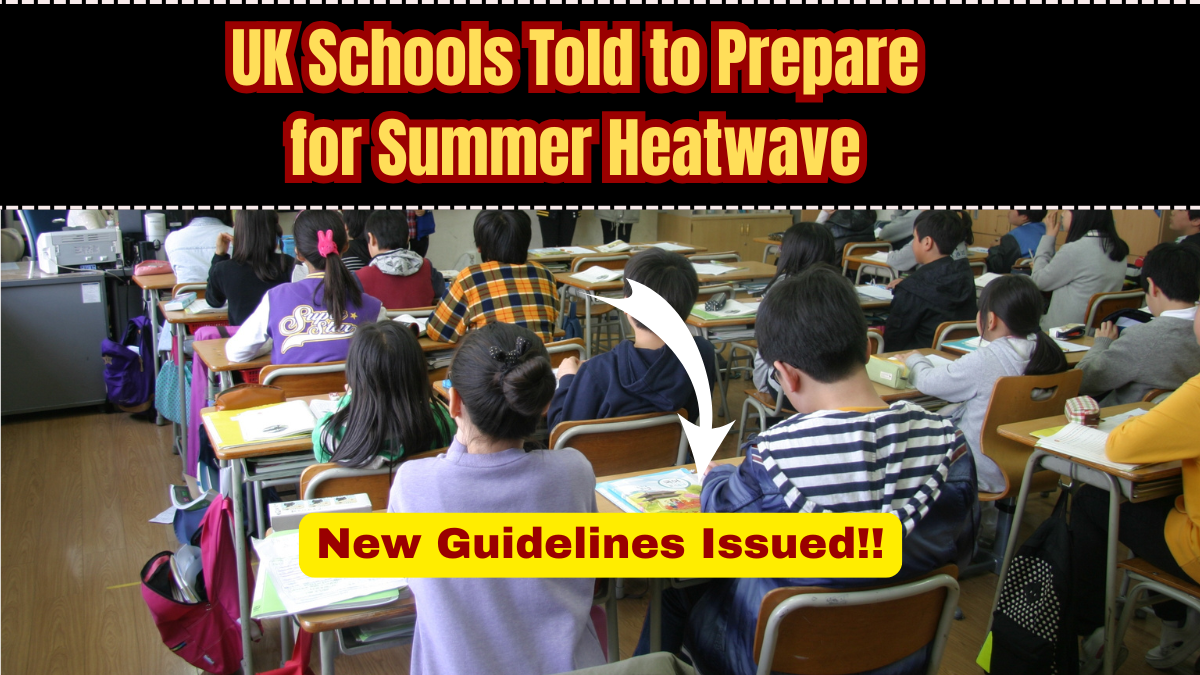As the UK braces for a potential heatwave in July 2025, schools across England, Scotland, Wales, and Northern Ireland have been issued new operational guidelines by the Department for Education (DfE) to prepare for extreme temperatures. With temperatures expected to soar above 34°C, these updated recommendations focus on student health, school infrastructure, and schedule flexibility.

Why Are Schools Being Warned About a July Heatwave?
The Met Office has issued a preliminary seasonal forecast indicating a prolonged heatwave pattern during July 2025, especially in southern and central regions of the UK. Rising global temperatures have made such events more frequent. Last year’s record-breaking summer heat has prompted preventative actions to reduce health risks for children and staff in learning environments.
The government has urged schools to take early steps including adapting school uniforms, rescheduling outdoor activities, and implementing cooling measures to ensure safety.
Key Changes in School Heatwave Guidelines for 2025
The DfE has introduced a range of updated instructions that all public and private schools must follow to maintain safe conditions:
-
Flexible Timetables: Schools can close early or delay start times when local temperatures exceed 30°C.
-
Cooling Infrastructure: Classrooms must be assessed for ventilation and schools are encouraged to invest in fans, blinds, and hydration stations.
-
Modified Uniform Policies: Students are allowed to wear light cotton clothing and remove formal attire during high heat alerts.
-
Playground and Sports Cancellations: Outdoor PE and sports days should be postponed or held only in shaded, cooler times (before 10 a.m. or after 5 p.m.).
-
Hydration Breaks Every Hour: Pupils must be given regular access to water. Water bottles are now permitted in all classrooms.
These summer heatwave preparations are designed to protect children’s well-being and reduce the risk of heatstroke, exhaustion, and related emergencies.
Regions Most at Risk from July Heatwave
According to Met Office models, the following regions could experience the highest temperatures:
-
London and Southeast England: Likely to reach 35°C+
-
East Midlands and West Midlands: Average daily highs of 32°C expected
-
Southwest and South Wales: At least 30–33°C for 5+ consecutive days
-
Urban areas across the UK: Heat build-up due to low airflow and concrete retention
Rural schools are also advised to monitor livestock, school gardens, and food safety protocols in school kitchens.
How Schools Are Preparing in Advance
Local authorities are distributing cooling grants and guidance documents to all state schools. Schools are being encouraged to:
-
Install CO2 and temperature monitors in classrooms
-
Develop an emergency heat plan with clear escalation procedures
-
Run heat drills similar to fire drills
-
Maintain daily communication with parents during heat alerts
Many schools in Manchester, Birmingham, and parts of Kent have already invested in solar blinds and ventilation improvements as early precautions.
The Impact on Academic and Extracurricular Activities
The July 2025 heatwave warning arrives during a crucial period for:
-
End-of-year exams and graduation ceremonies
-
Summer term projects
-
Outdoor learning programs and school trips
To limit disruption, schools are being asked to transition some activities to virtual formats, shift schedules, or relocate events indoors.
Parents are also being advised to apply sunblock, pack extra water, and dress children in heatwave-appropriate clothing. Education leaders stress the importance of collaboration between schools, families, and local councils.
Public Health Agencies’ Role During the Heatwave
In coordination with schools, the UK Health Security Agency (UKHSA) has issued health protocols that address the risks to vulnerable children with asthma, epilepsy, or pre-existing conditions. Nurses and staff are required to monitor children for:
-
Signs of dehydration: fatigue, dizziness, dry lips
-
Heat rash or sunburn
-
Heatstroke symptoms: high temperature, vomiting, fainting
Emergency hydration stations and shaded rest areas are being set up in some schools to ensure immediate relief when needed.
Looking Ahead: A New Normal for UK Education?
Experts warn that extreme summer weather may become a recurring issue. The Department for Education is working on long-term infrastructure changes, including:
-
Green roofs and reflective paint on school buildings
-
Climate-resilient school design guidelines
-
More term-time flexibility during summer months
The July 2025 heatwave guidelines could set a precedent for future summers as the UK continues to adjust to climate extremes.
FAQs
What temperature triggers school closures in the UK?
While there is no legal maximum temperature for classrooms, most schools consider adjusting schedules or closing early when indoor temperatures consistently exceed 30°C.
Are schools allowed to relax uniform rules during heatwaves?
Yes, updated guidelines allow schools to implement relaxed dress codes such as t-shirts, shorts, and sun hats during extreme heat.
What is the government doing to help schools stay cool?
The DfE is offering guidance, funding for basic cooling infrastructure, and has published an emergency response plan for all educational institutions.
Can students still take exams during heat alerts?
Yes, but schools are advised to offer hydration, use fans, and where necessary, reschedule or relocate exams to cooler parts of the building.
Click here to know more.
